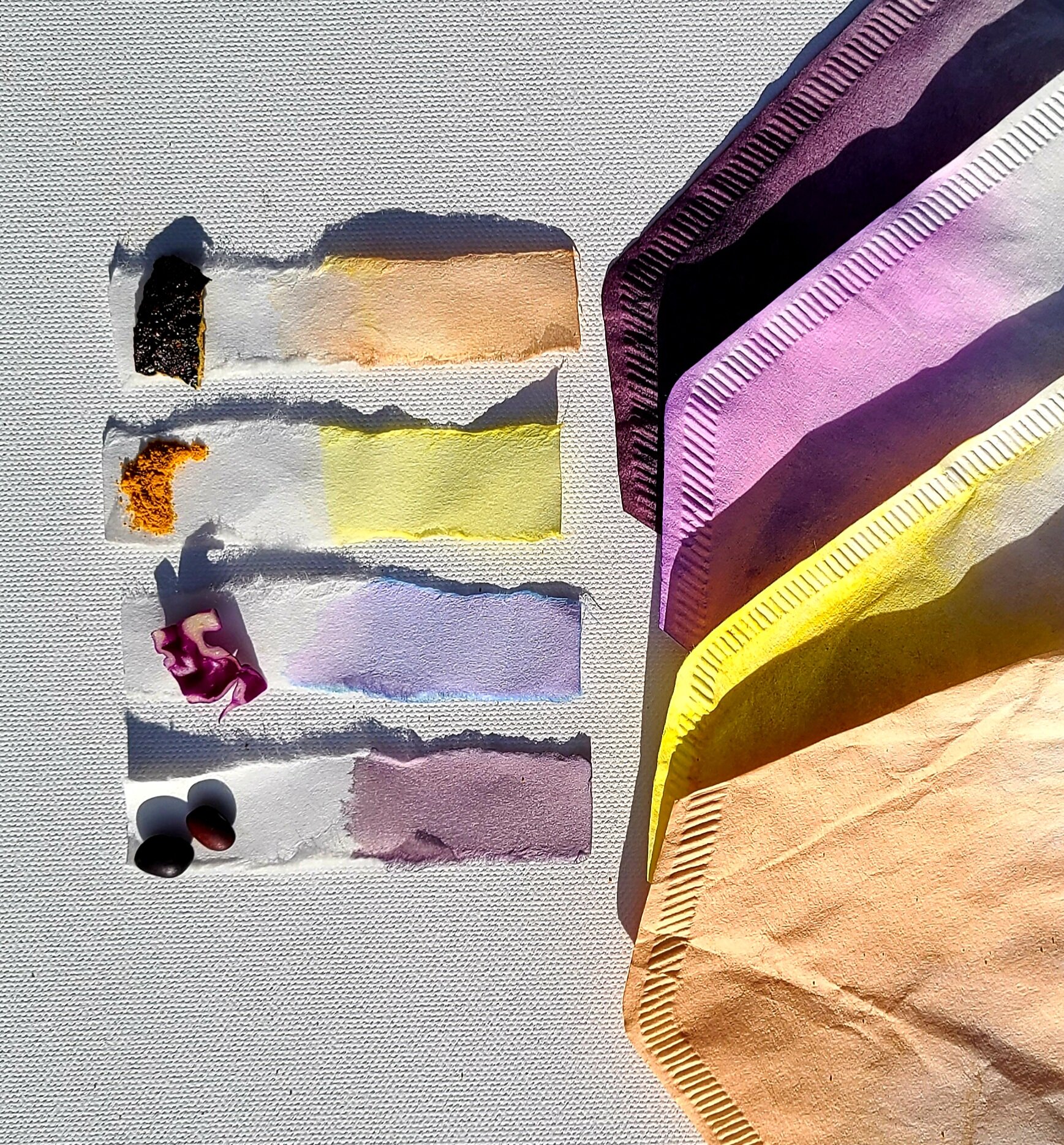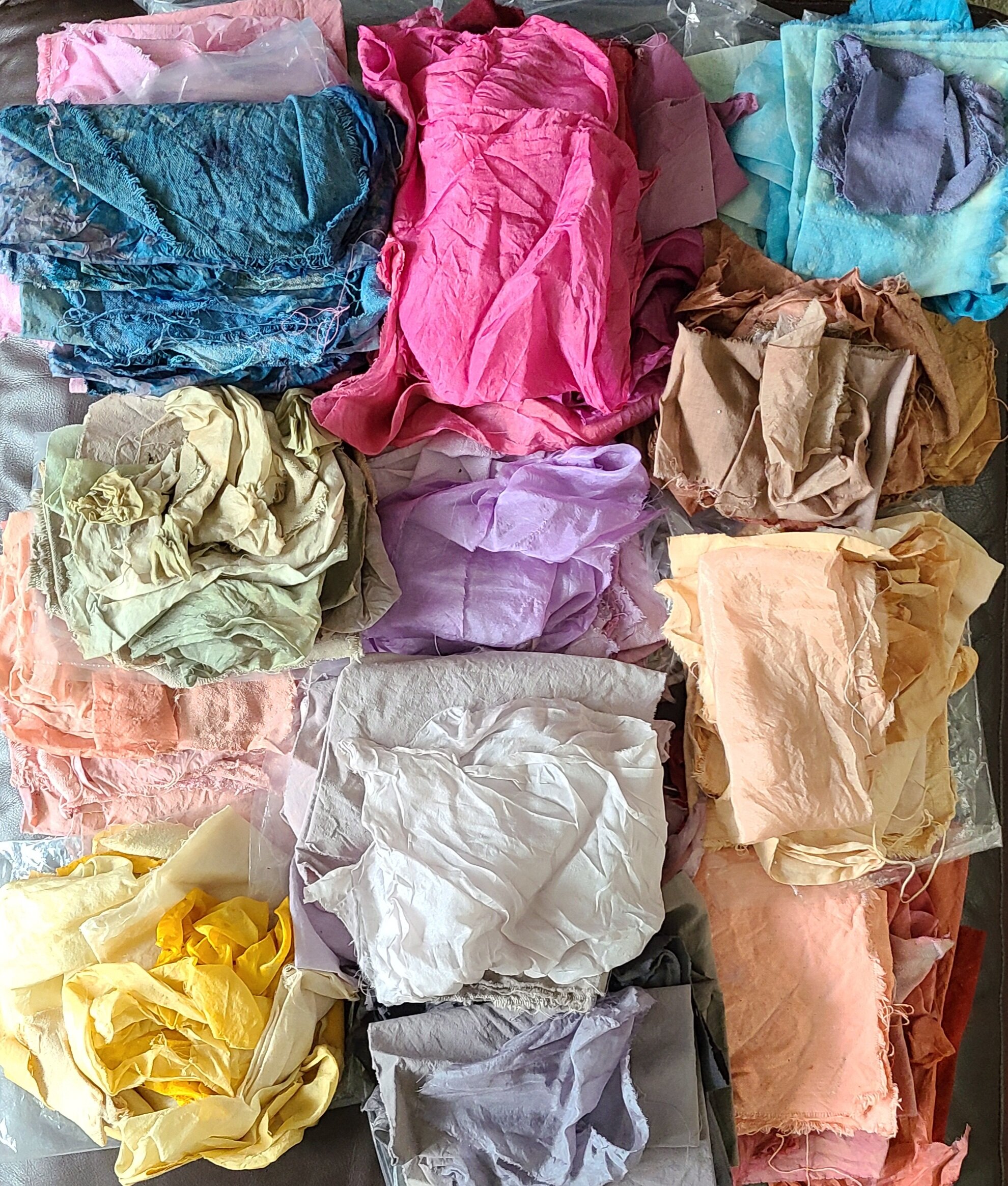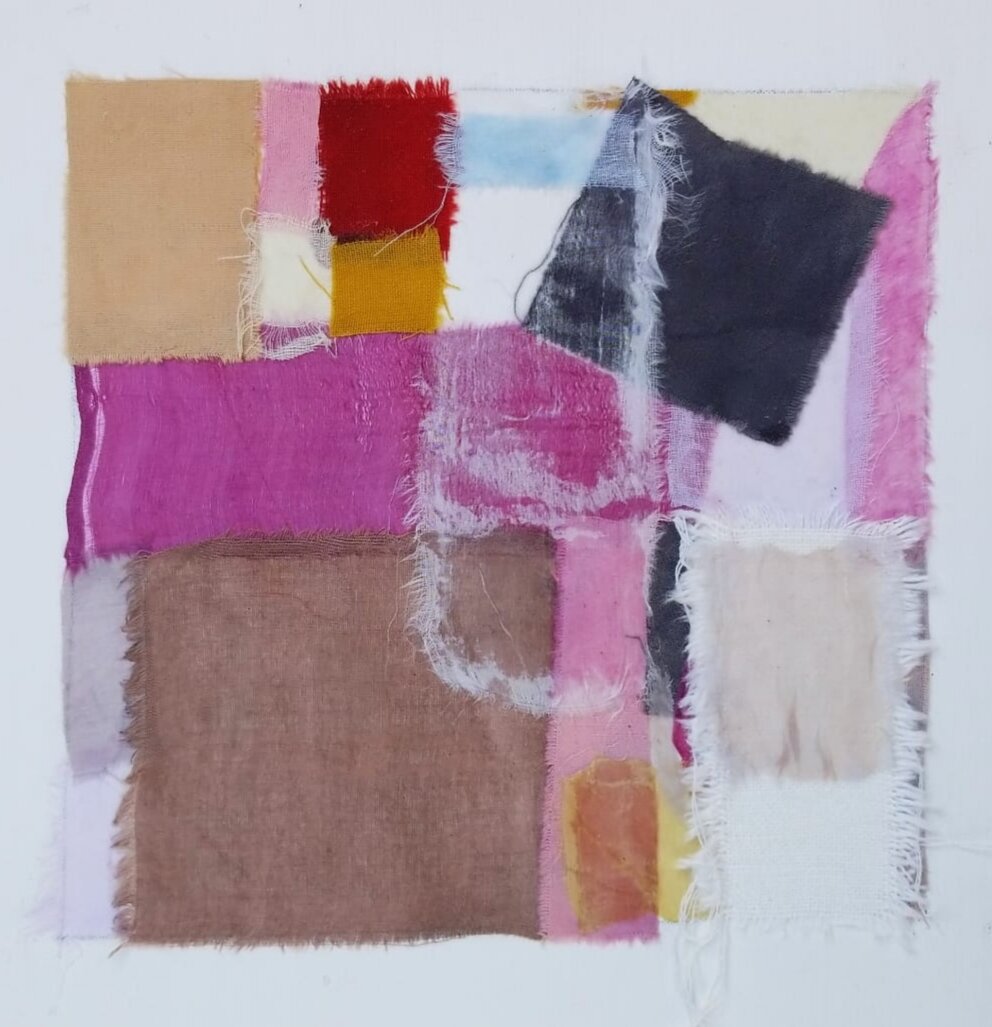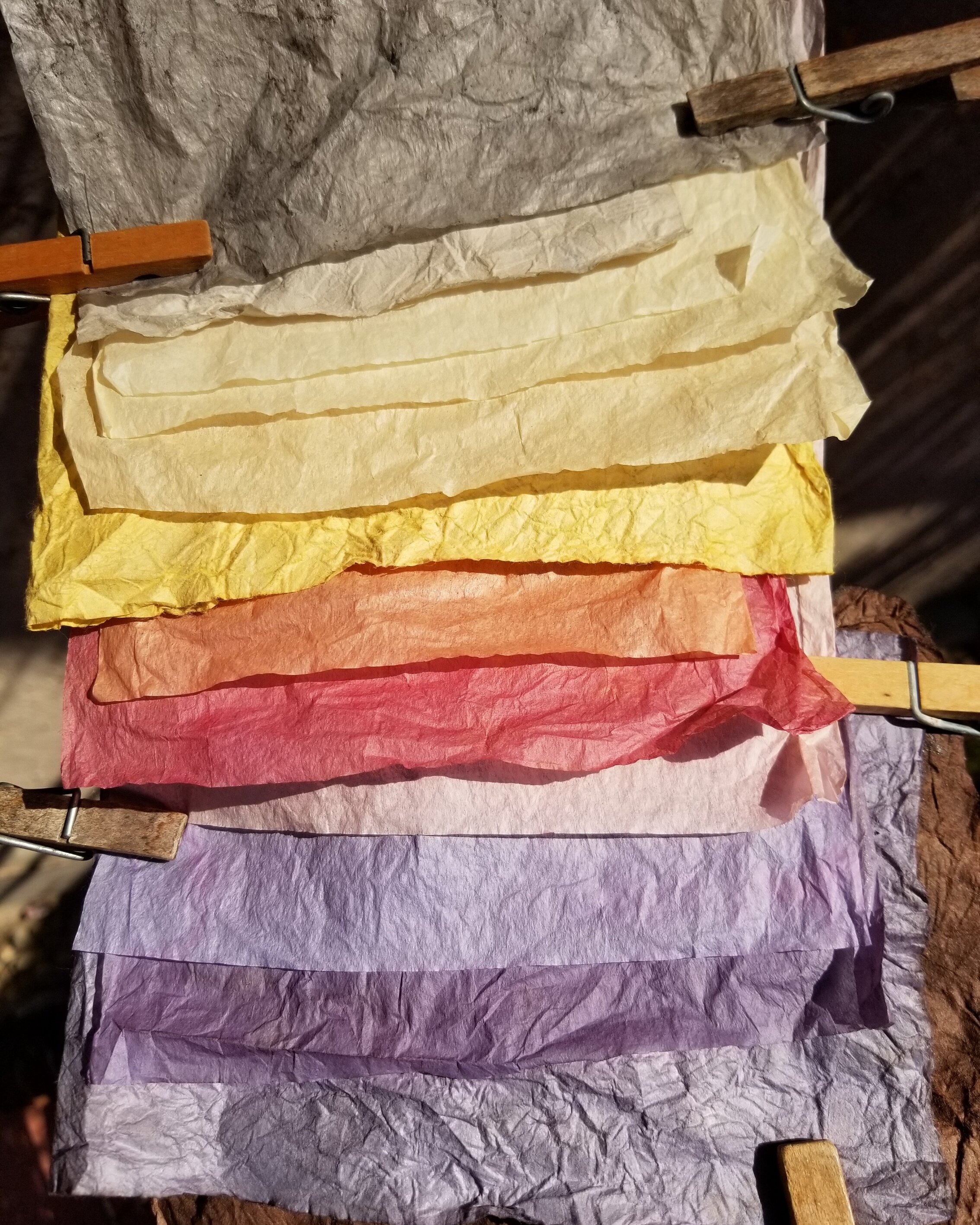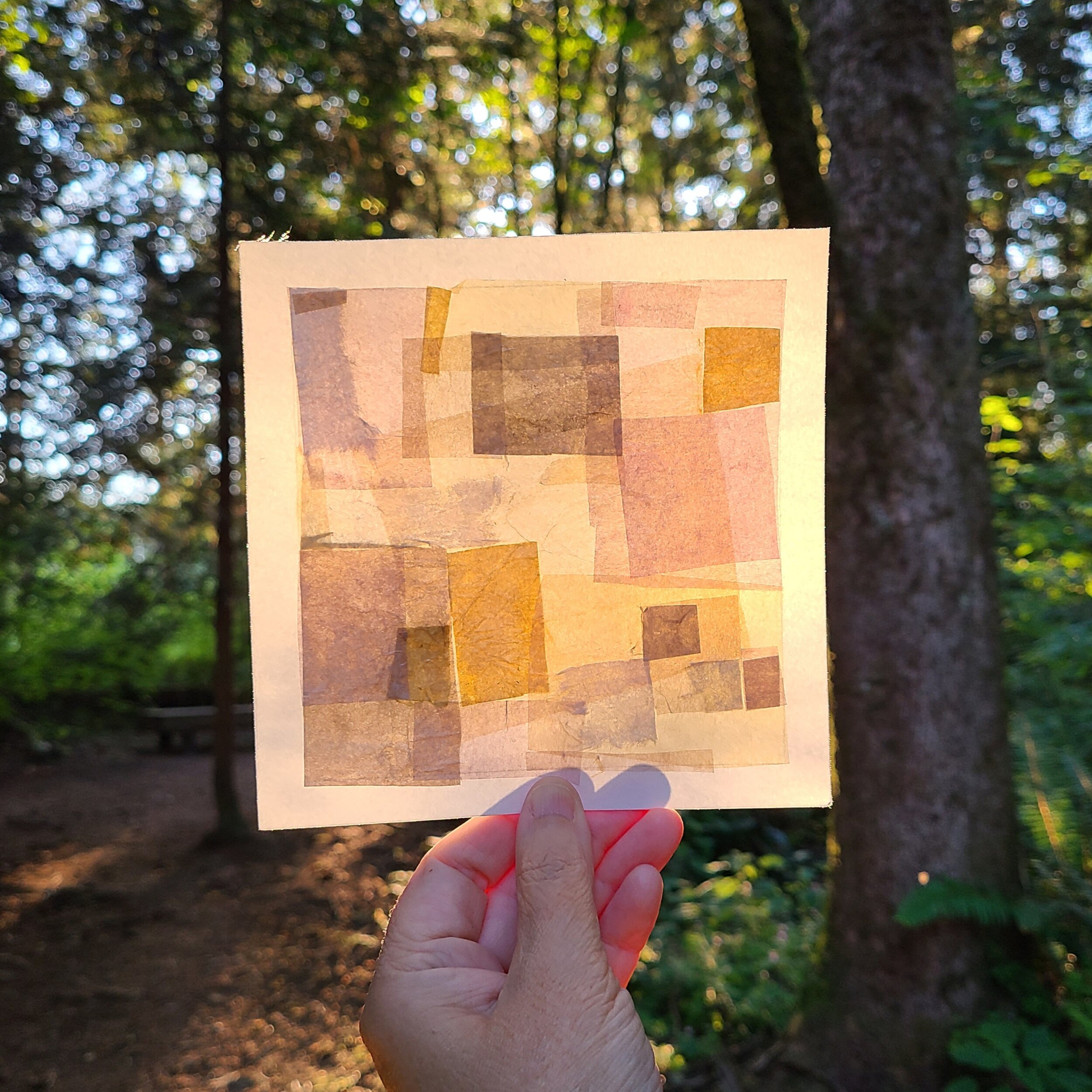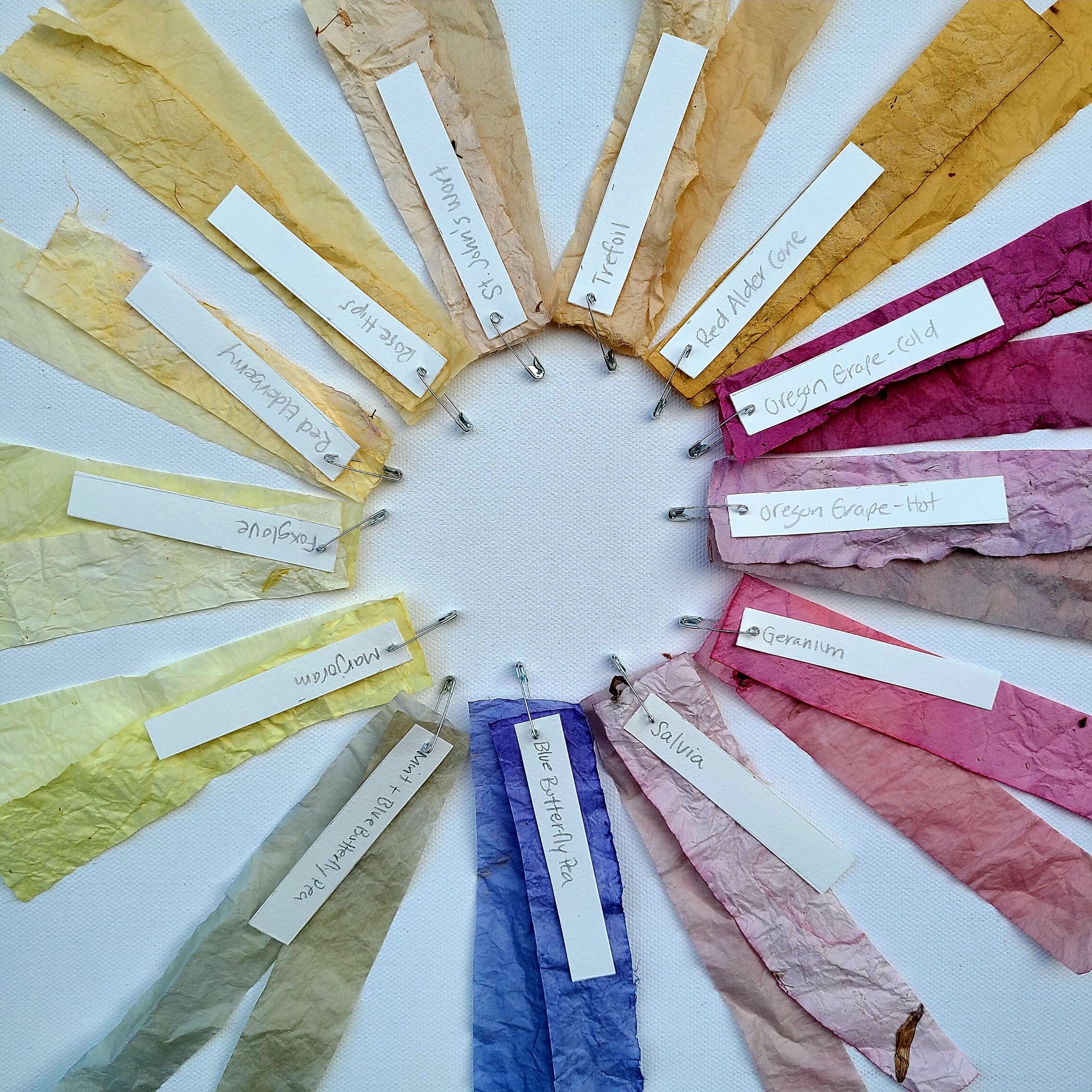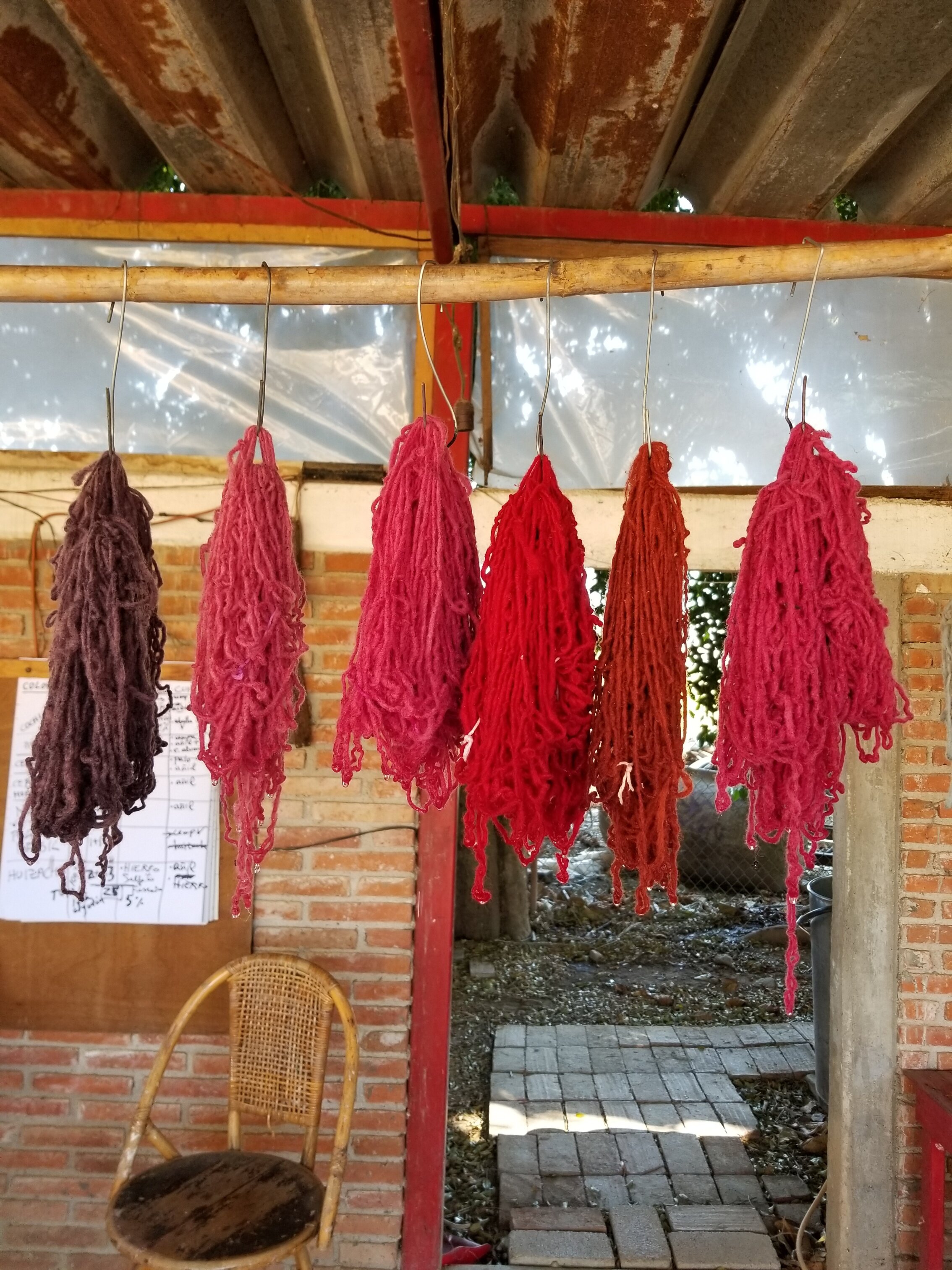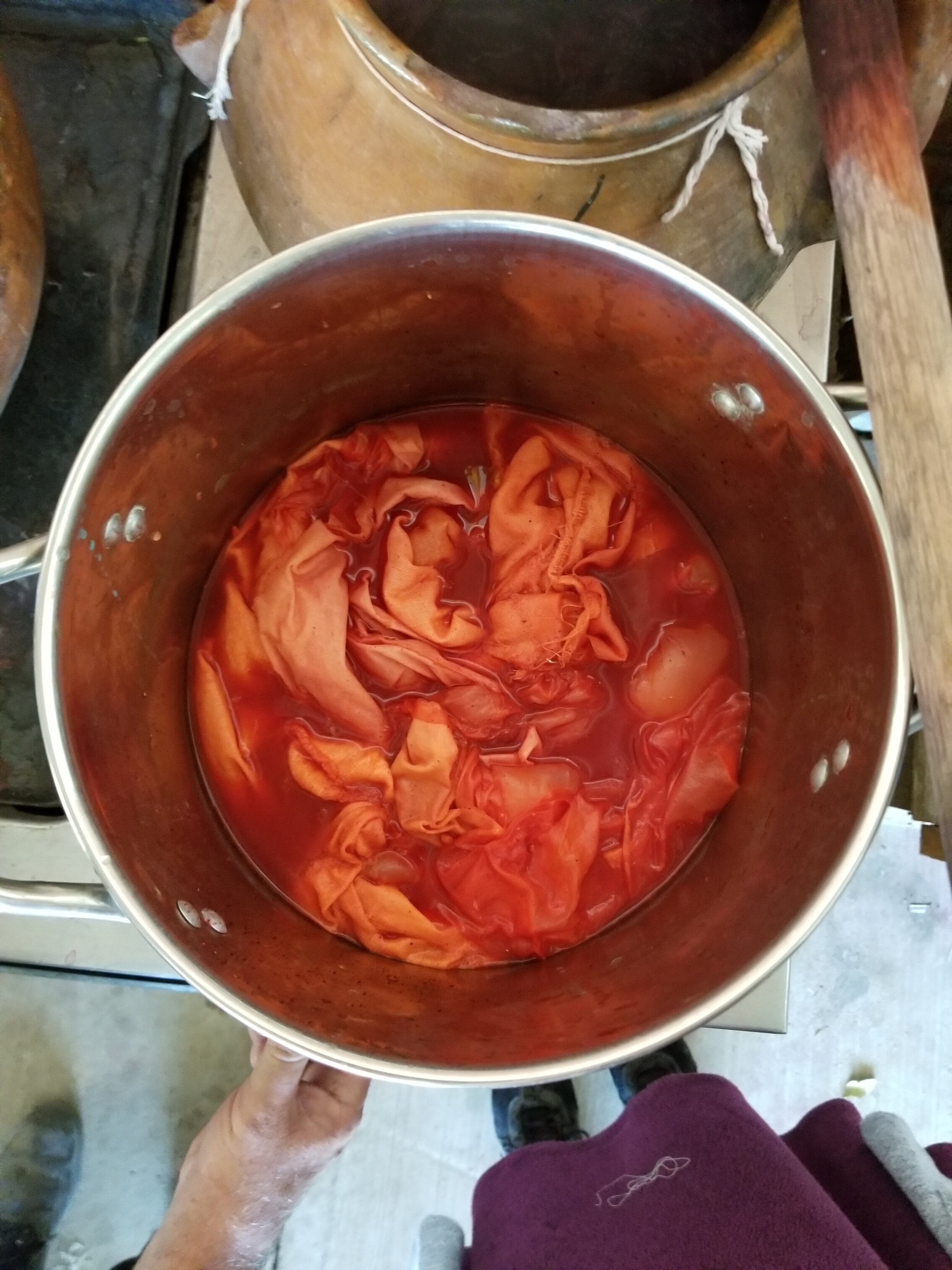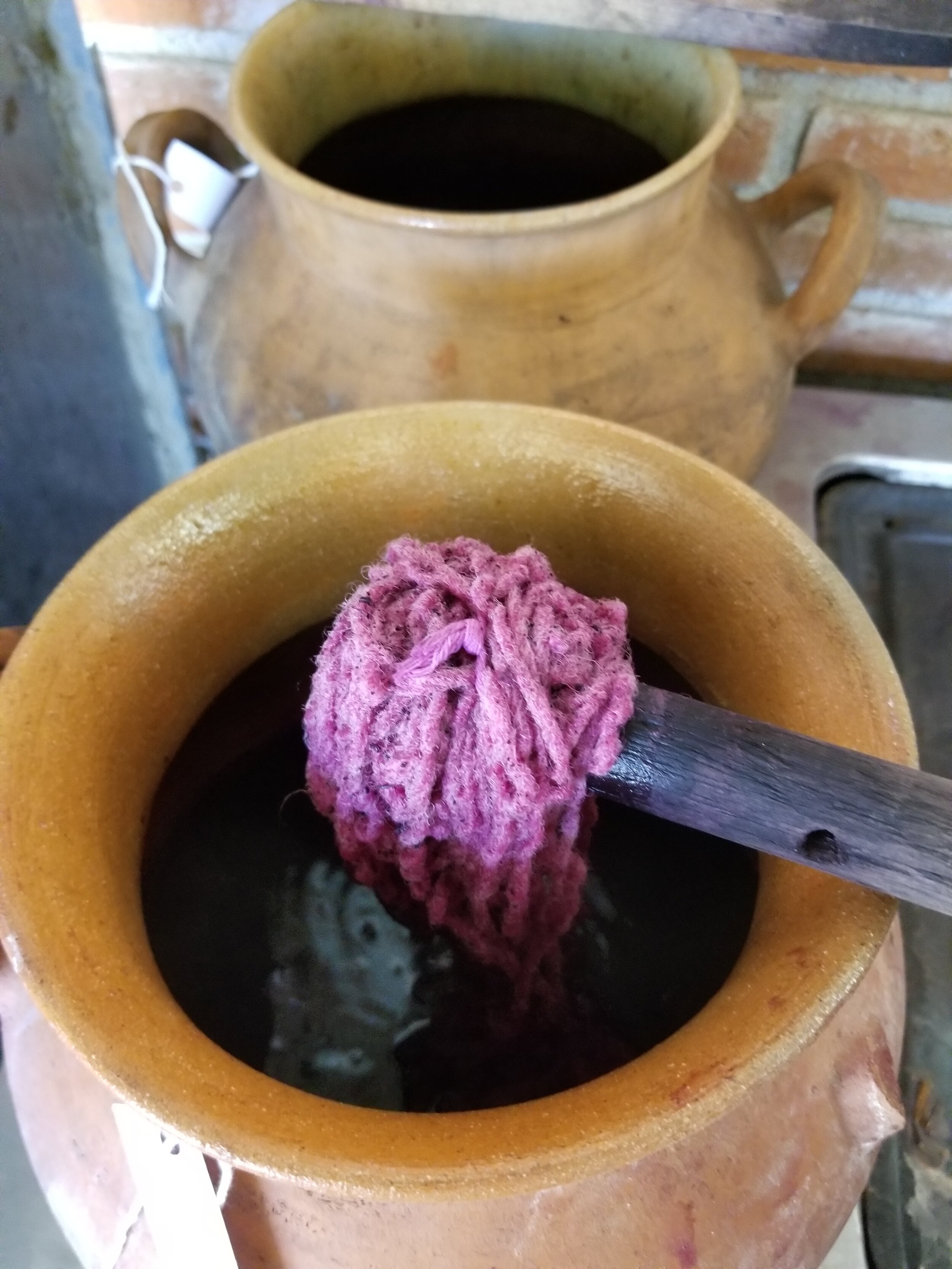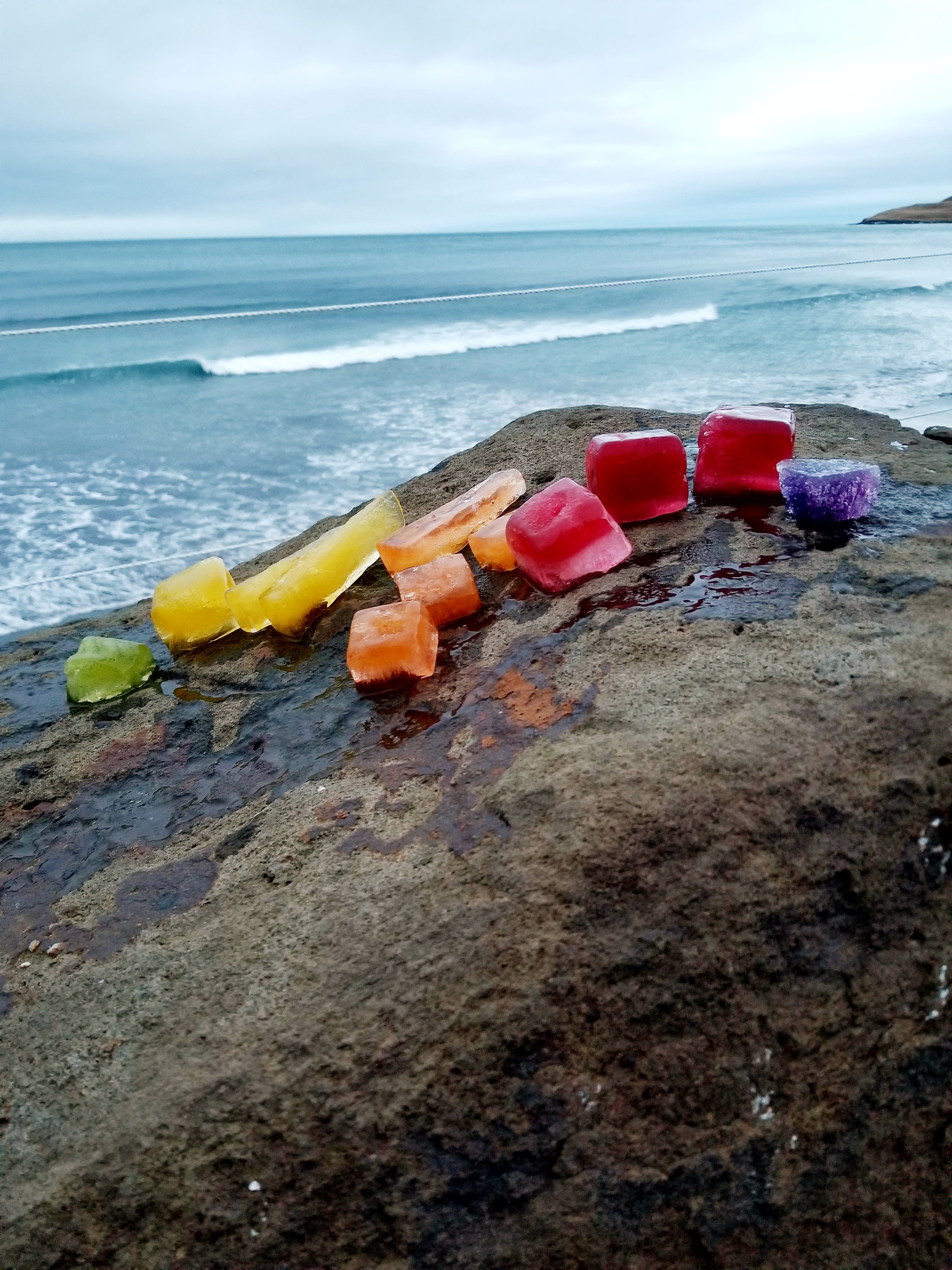Raking leaves in autumn is a perfect way to forage natural color right in your back yard. Japanese maple leaves create a pink/mauve dye for your textile and craft projects by simply chopping them up and throwing them in a pot of simmering water. Rich in tannin, the dye forms a strong bond with the textile that is long lasting and safe from light and water. This tutorial will show you how to forage and brew dye from Japanese maple leaves, as well as deepen the color with an iron water bath. You will see the resulting color swatch samples (cotton & silk) with various mordants.
Iron Water
Iron is a great way to shift your naturally dyed fiber to darker shades quickly and easily. Make your own homemade iron water with 3 simple ingredients: rusty nails, white vinegar and water. After a few weeks, your iron water is ready to go! You only need a splash, so store it away to use any time you are looking for darker shades including gray and black. This video tutorial will show you how to make and use iron water, as well as the resulting color swatch samples of 6 different natural dyes on cotton.
pH Shift
Red cabbage makes a gorgeous purple natural dye, but did you know it is also a color shifter? By changing the pH of the water with simple ingredients in your kitchen, red cabbage dye can turn to luscious pinks and vibrant greens. This tutorial will show you how to brew 4 different colors from red cabbage, as well as the resulting color swatch samples (cotton & silk) of all four dyes.
Red Cabbage
Red cabbage is a natural way to create purple dye for your textile and craft projects by simply chopping it up and throwing it in a pot of simmering water. The leftover 'soup' will be a vibrant dye that colors your fiber shades of lilac and lavender to deeper violet tones depending on your textile. This tutorial will show you how to brew dye from red cabbage, as well as the resulting color swatch samples (cotton & silk) with various mordants.
Black Bean
Black beans are a natural way to create blue dye for your textile and craft projects by using a cold process. Are you soaking black beans for a pot of soup? Fantastic - just let them soak an extra day and the thick leftover water can be saved for a blue that can have hints of green, purple and gray. This tutorial will show you how to create a 'cold brew' for a lovely blue dye, as well as the resulting color swatch samples (cotton & silk) with various mordants.
Spinach
Spinach is a natural way to create green dye for your textile and craft projects by using food from your kitchen or garden. Did you forget the spinach in the back of your fridge? Even better! Wilted leaves that are past their prime can help coax out that green dye. This tutorial will show you how to brew a subtle green dye, as well as the resulting color swatch samples (cotton & silk) with various mordants.
The Art of Craft
Small craft advisory
As an artist, I aspire to be crafty.
Forget the misguided, and tragically oppressive Western narrative of ‘high art’ as somehow ‘enlightened’ and more valuable than the exquisite beauty found across all creative expression labeled as ‘craft’.
If you can translate an idea from mind to hand, the material is immaterial – you are an artist - plain and simple.
My creative curiosity has led me down a crafty path or two, and I’m now enamored with one diversion so often associated with handiwork: natural dyeing.
Some of my kitchen favorites for natural dye: avocado, turmeric, red cabbage and black bean.
While I could fight against the notion that this diminishes the value of my art, why would I entertain such a silly thought?
Nope. I choose to celebrate, my artist friends, so let’s get crafting with natural color!
Color classics
Focusing on colors from nature in #The100DayProject has filled my fridge with an incredible rainbow of botanical dyes.
Dyes brewed from foraged plants and food scraps during #The100DayProject.
Every time I find a new plant to brew, I add to my collection. When I see a color missing, I go searching for a plant. It is a never-ending exploratory cycle.
10 dye plants foraged from Tambark Park and my garden waste to study local flora colors.
As I shared my project, and the art I created with these dyes, I could hear the buzz all around me as people became curious themselves. Certainly interested, and maybe even inspired, to learn about natural dyes.
I get this. I have a history of being intrigued myself. It’s how this passion for organic color grew and how I learned what I know so far. Ironically, it seems the more you know, the more you want to know.
Having had many of the same questions when I started my love affair with nature’s palette in 2017, I have been searching high and low for answers ever since.
When I learned from a Dutch artist that seaweed was a sustainable source of dye, I headed to Iceland to investigate.
And, because sharing is caring, I’m very excited to tell you a secret I’ve been keeping all to myself:
Starting in August 2020, I will be releasing short tutorial videos and mini-courses all about the incredible world of natural color. My intention is to build a place where you can easily find the basics to get you inspired to add color to your life naturally.
Soon to be released YouTube channel, Cookin’ Color, with short video tutorials on organic dyes, August 2020.
The topic is HUGE. There are so many options and different approaches to extracting color, plus a multitude of ways to use it.
For me, organic color has been an integral part of my installation practice, and more recently my mixed media work. But a beautiful aspect of natural color is that it is available to everyone, no matter where you consider yourself on the art/craft spectrum.
Bioplastics cooked and cured with natural dyes in my kitchen studio in June 2020.
And, the botanical dye in my fridge right now is a perfect example of the countless ways we can weave natural color into almost everything.
Nature’s bounty
Finding a way to create color in an ephemeral installation without hurting an environment is how I got hooked on natural dyes. But as my #100DaysOfNaturesColors meandered its way through botanical dyes and earth pigments, I could clearly see just how many different ways I have been exploring color from nature. Maybe one or more of these will strike a creative chord with you too!
TEXTILE
Probably the most obvious and popular use of natural dyes is to create sumptuous hues for fabric. With a growing interest of sustainability in fashion, botanical colors are popping up from head to toe. If you’ve got natural fibers in your closet (cotton, hemp, silk, wool), you can dye organically – the options are endless.
Textiles of wool, silk, cotton and bamboo hand-dyed in Oaxaca exclusively with organic matter.
My first on-line workshop will be on how to create an ombre-dyed scarf from foods in your kitchen, and this fall, I will be teaching a similar technique using earth pigments. Incorporating these rich colors into a wardrobe is a delicious way to get your art out of the house.
However, if knitting or weaving is more your speed, soaking yarn, string or ribbon in a batch of botanicals can create subtle sweetness. Just look at the wonder of this wool I dyed in Mexico.
Wood hand-dyed in organic matter including indigo, muicle, pericon and cochineal in Oaxaca, Mexico.
While I preferred to use this fiber for installation, imagine a hat, scarf, mittens or sweater with that special colorful touch?
But who says you have to wear hand-dyed textiles? My mom was an avid quilter which I’m certain has influenced my mixed media textile pieces and love of squares.
Naturally dyed textile piece, Blossom, created while on residency in Oaxaca, Mexico, March 2020.
How special it would have been to forage with my mom and organically dye fabric swatches for her to sew into her quilt creations. Keep that in mind for the quilters in your life.
PAPER
Textile’s extended fiber family is paper. The delicate translucency of paper has intrigued me for quite some time, both for sculptural and 2D applications. In Oaxaca, I first tested how wet strength fibers like mulberry and tissue would hold the colors I had brewed, and it worked like a charm.
First time hand-dyeing paper with plant matter in Oaxaca, Mexico, March 2020.
So, one chunk of 10 days during #The100DayProject, I focused on creating collage with these dyed papers. The variations of color, especially when layering, felt closely tied to the depth I love to create with overlays of silk in my textile pieces.
Hand-dyed paper collage backlit in Tambark Park, made exclusively from organic dyes foraged in Oaxaca, Mexico.
Feeling inspired, I foraged local ‘weeds’ in my beloved Tambark Park the last 10 days of the project and made a new rainbow stock of colorful paper from the PNW.
Paper samples of natural dyes brewed from foraged plants in my neighborhood. Only blue butterfly pea was from my kitchen!
What’s wonderful about paper is its versatility across several art disciplines, and a true staple in many craft projects. Why not make hand-dyed paper with plants foraged from your neighborhood the next time the scissors and glue need some exercise?
INK
Dyeing paper is one way to spread some of nature’s colors around, but making ink turns just about any organic matter into a medium for drawing and watercolor fun.
I simply poured the dyes I brewed from foraged plants in Iceland and Mexico on paper, but learning how to make ink specifically was yet another way to expand my natural color wheel during the last 100 days.
Testing inks made from avocado skin and red cabbage during #The100DayProject.
I even made blue ink with my cherished blue butterfly pea blossoms for the first time, one of the most elusive colors of nature.
Watch out - lake pigments might be just around the next corner!
KITCHEN KRAFT
While all of the above may result in time at a craft table, a stovetop is still a critical element in a studio of natural dyes. Therefore, it’s no surprise that crafts of the kitchen can also add a splash of organic color.
Much of my installation work was born in the kitchen - infused ice, mung bean and playdough have been some of my edible shining stars.
Mung bean string installation naturally dyed with kitchen scraps in Sayulita, Mexico, December 2018.
Brewing organic dyes as natural food coloring for baking, cooking and blended drinks is certainly a fun way to add color in the kitchen. At the very least, you can start with next year’s Easter eggs having that natural color vibe.
This year’s Easter Eggs were dyed au naturel in turmeric, red beet, red cabbage, avocado and blue butterfly pea.
Plus, the kitchen is the perfect place to start playing with natural dyes in general. So many fruits/veggies, spices and even food scraps can make wonderful colors with very simple recipes.
In case you missed it this spring, download a copy of my Cookin’ Color brew booklet with a few of my favorite kitchen dye recipes, or better yet, sign up here for my 5 Days of Dye short video tutorial series releasing soon in a kitchen near you!
HEADING
Go ahead – call me crafty. I don’t mind at all.
To be honest, I question why any negative association became attached to a word that honors the vision and skill it takes to create beauty with your hands. To be an accomplished craftsperson is a lofty goal for any artist, and certainly one I aim for in my daily practice.
So, let’s keep spreading the art of craft in the world today!
The colorful Mr. Biv
The stuff of rainbows
Don’t know about you, but I have a handful of tricks up my sleeve to remember trivial bits of information. I am the maven of mnemonics:
Need to know how many days there are in April? Got my knuckles for that.
That 5 letter Great Lake messing up your crossword puzzle? Try H.O.M.E.S. on for size.
Pulling out the crayons to draw your sweetheart a rainbow? I’d like you to meet Mr. Roy G. Biv
I think it was my grade school art teacher, Mr. Malley, who taught us how to remember the seven colors of the rainbow. (Yes, I had a full time art teacher with a dedicated art room when I was a kid!).
Mr. Biv has been a tool in my paint caddy ever since.
The organic colors of the rainbow hand-dyed on paper in my residency studio in Oaxaca, Mexico.
So, of course, Mr. Biv was my travel companion to my artist residency in Oaxaca, Mexico, last month as I continued my quest to find the rainbow in nature’s palette. Let’s just say, we found all seven of his colorful letters and then some!
Red
The color of love (among many other things) is a highly sought after hue that has a history connected to imperialism and revolution. Minerals of hematite and cinnabar, the root of madder and several parasitic creatures have been foraged and crushed so we can bathe in red.
One insect in particular has become the darling in the wide world of dye: cochineal.
I had only bumped into cochineal about a year ago when I was preparing for my residency in Iceland. Visiting a dye master in the countryside two hours north of Reykjavik, Guðrún Bjarnadóttir shared the secret sauce of her scarlet wool yarn.
The gorgeous hand-dyed Icelandic wool of Hespa Iceland. Looks like a neutral cochineal soak to me with those bright fuchsias peeking through.
She had a large jar of cochineal that she imported to Iceland as her ancestors had done before. You see, red and its variations are not natural colors found in Iceland.
Cochineal is a parasite that lives on the nopales cactus indigenous to present day Mexico and Peru.
The white powder of the cochineal insect dusting nopales cacti before harvest.
Contrary to what you may think, the red comes from carminic acid, not blood, which acts as a deterrent against predators. Or, if you are human, it seems you are wildly attracted to it!
Working for three weeks on a cochineal farm in Santa Maria Colotepec in Oaxaca, Mexico, the secrets of its beauty were slowly revealed to me.
All the lovely shades of cochineal hanging out in wool yarn on the farm near Oaxaca, Mexico.
But, not only did this tiny insect produce the most amazing carmine color, it played a starring role in many of Mr. Biv’s letters.
Orange
Beyond the measurements I wrote about in last month’s Trail Tale, dyeing incorporates some elements of chemistry.
Who remembers those little litmus strips from your high school lab? Well, turns out cochineal is sensitive to the pH level in the dye bath. Add a bunch of lemon juice, aka. acid, and mira - orange!
Shifting cochineal neutral by squeezing lemons. The secret of playing with pH!
Makes me chuckle to think that adding yellow to red actually makes orange in this corner of the dye world. Trust me, that isn’t a hard and fast rule in dye chemistry, but cochineal happily plays along.
Yellow
I know what you’re thinking: lemon juice must be a key ingredient in yellow dye. Nope. I have recently seen Sasha Duerr, a natural dye specialist, create yellow from citrus skins, but in Oaxaca, we used pericon.
You may know this native herb as Mexican tarragon or marigold, both of which are used as dye in other parts of the world. The pericon grown and harvested on the cochineal farm, however, produced a gloriously vibrant yellow that demanded visual attention.
The green leaves of pericon cooking up some instense yellow on silk strips I used for installation in Oaxaca.
Move over marigold – you may have a rival nipping at your heels, but pericon may be tough to find in my local PNW nursery.
Green
When it comes to the plant world, it’s not easy being green.
Both, Guðrún Bjarnadóttir and Manuel, my Oaxacan dye master, utilize the primary color theory to achieve green. First you dye with yellow (pericon or another yellow source), and then you over-dye with blue (indigo), another elusive color rarely found in nature. Voila - green!
Although I attempted this on the farm with my wool yarn samples, I struggled with the indigo (more on that below). That didn’t stop me from experimenting in my own dye studio on days away from the farm, and I had some success.
Who knew the cold sludge of fermenting black beans could tease out such gorgeous greens?
No over-dye step required here. Just a 2 day cold soak in fermented black beans!
I was expecting a grayish blue dye result when I bought the dried beans in the Mercado 20 de Noviembre. You just never know with natural dye - the surprise element is one of its sweetest characteristics.
Blue
If you think red is tough, you haven’t met blue yet. Treasured minerals of lapis lazuli and azurite are pigments of royalty. In the plant kingdom, indigo is queen.
The cochineal farm is an educational venue exclusively focused on the natural dyes of the region, and indigo has roots in the tropical climate of the Oaxacan coastline. Manuel grows every plant we used on the farm, but his indigo suffers in the dry heat. So, as traders have done for centuries, Manuel brings his indigo crystals from the coast.
Grinding indigo with mortar and pestle before adding it to the dye pot.
Extracting color from indigo is a labor intensive process and one that requires humility and reverence. I was quickly humbled by the mystery of blue.
Indigo
With all the work that went into making 12 dye pots to create 40 unique colors over three weeks, saving indigo for last didn’t surprise me. However, I soon realized that rushing indigo at the end did not honor its spirit, and so it did not fully share its color with me.
The many shades of indigo from an ignored dye pot hanging out with no-fuss cochineal orange.
When I explained how tough my day with indigo had been, a local artist told me the secret of the blue goddess: one must be fully present without distraction or haste.
I love this thought. It rings true across so many aspects of life, and so now indigo is yet another gentle reminder of the beauty of presence.
Violet
The last letter in Mr. Biv’s name was a dual effort in the organic realm. That sneaky, chameleon of a dye, cochineal, can be shifted to a yummy color of the violet persuasion. All the alchemist has to do is sprinkle in minerals (various recipe options) which can shift the pH balance to alter the hue.
Cochineal neutral plus 15% alum working its violet magic!
No minerals to be had – no problem: muicle to the rescue! Picking the leaves of this medicinal shrub on the farm produced a lovely violet dye as well. I doubt these leaves are sold in my local farmer’s market, so they may be a color treat solely for the Oaxacan palette.
Dye me a river
The colorful experience I was so lucky to have in Oaxaca is not soon to be forgotten. Just ask Mr. Biv.
But, that hasn’t stopped me from building my own mnemonic device to capture some of the amazing tips I learned, and a few of the easy kitchen recipes that can produce a rainbow.
Feeling inspired to get your dye on now? Click here for the Cookin’ Color Brew Booklet to see if you can catch Roy G. Biv just like I did!
xoxo - Byrdie
2D or not 2D - that is the question?
To flip is to flop
One pair of flip flops is all this artist needs. If I didn’t love the polar north so much, my toes would always be exposed in the only shoes in my closet. One pair, no choice, no problem.
Flip flops were made for installation! Placing a few colorful sticks on a dock in Union, Washington.
Asked to choose between chocolate or vanilla, the bean made of cocoa would win, even though chocolate chip ice cream would be the obvious solution. One flavor, no choice, no worries.
Canine or feline? That’s easy – woof. One pet, dirty house, ugh.
Meet Callie - resident studio dog, lover of eggs and cheese, and one giant fur ball!
Having choice is one thing, but having to choose is quite another. As much as I like to believe in the power of choice, I also recognize that I prefer fewer options, thus making the selection process quick and easy.
So, in a world where there are endless possibilities, why are we asked to pick a favorite, to choose one instead of the other?
I ask this because in the world of art specifically, I can’t choose, and quite frankly, I don’t want to. It’s the one area where I want to try everything (ok – maybe not realistic figure drawing!), and for once, the more options I have, the more my creativity can thrive.
Stack Shack in all of it’s macro glory! A rainbow of organic dye in Þingeyri, Iceland, February 2019.
2D+3D=5D. Now that is math I can get behind!
Tik Tok
Wait…there is one more area where I long for a ‘sky’s the limit’ kind of choice: Travel!
No surprises there. When Chris asked where he could take me for my 50th birthday, the list of options, places high on my bucket list, was lengthy. In the end, the choice, Lofoten, Norway, wasn’t difficult because I still have so many amazing landscapes to discover. There is time and it will never be too late.
Chris and yours truly leaning into the wind on our way to Lofoten, October 2018.
And these words perfectly describe how I feel about my creative journey. Yes, it appears my passion has led me to installation, filled with all kinds of delicious sculptural material to build, but the photographer in my DNA is itching to compose a still life of my creations. Not sure what the painter in me thinks about all this craziness, but she’s okay to fling some color around in the meantime. There is time.
Resident artist
Even with the wanderlust and countless corners of the globe to explore, I seem to choose Iceland again and again, just like those worn out Havaianas. This time (February 2019 to be exact), however, I decided to return to that enchanting island near the Arctic Circle to explore my love of the fifth dimension.
Shot Glass installation on the beach of Þingeyri, Westfjords, Iceland, February 2019.
For my first artist residency, I proposed to dive deep into extracting organic dye from the land and sea of Þingeyri, Iceland in the Westfjords. With these colors from nature, I would experiment across mediums, and one might even accuse me of stepping into the craft side of the arts’ universe: Dyeing fabrics, installing the frozen liquid across the village and pouring it on paper to see how seaweed, lichen, cabbage and kale would soak into washi. Is she a cook or a seamstress? A forager or a printmaker? What is this artist crafting now?!?
My warehouse studio at the Westfjords Residency. Cold, but oh so spacious!
Passion…
Palette perfection
Ten days in a remote fjord in the middle of winter was the perfect setting for limited choices. It was exactly the wildly windy silence I sought to focus exclusively on creative expansion. Choosing only four organic substances for extraction also felt comfortably restricted. My reward in the sparseness was a beautifully abundant color palette only Mother Nature could create.
Seaweed, lichen, cabbage and kale - oh my! Organic dye in all it’s natural wonder.
From simplicity came the complexity I seek in my art practice, a choice I may never have made on my own.
Any doubt lingering in my mind about a need to choose just one discipline continues to dissipate. What my Icelandic residency gave me was not only a deeper understanding of organic dye, but a sharpened curiosity of how I might use it’s subtle beauty across varied platforms. Iceland also gave me some amazing artwork!
Building a body of mixed media work from the Iceland series. Organically dyed fabric on canvas, 12x12 inches.
Letting it slide
One pair of snow boots is all it takes to keep this artist’s toes toasty in the Arctic chill. Four times over eight years, no change, all good.
One pair of boots and a bucket of ice. What more does an artist need?
In February, I also brought a pair of slides to Iceland, my winter version of flip flops. As we made our quick exit to beat the blizzard winds threatening to strand us another day in the Westfjords, I accidentally left my slides behind.
Note to self: I only need one pair of shoes wherever this journey takes me.
Kisses - Byrdie
Barefoot in a Sneaker Wave
Better get your trench coat
From 16,000 feet deep in an under-water ravine to the crest of an 8-story thundering wave, the coast of Nazaré, Portugal has a magnetic pull. In the churning Atlantic water of Praia do Norte, hard-core surfers, and spectators alike, plunge into the wild world of big wave surfing. In fact, in November 2017, Brazilian surfer, Rodrigo Koxa, broke the world’s record by flawlessly riding this massive 80 foot wave, honoring a life-long passion.
First and last time on a surfboard in 8 inch surf at Praia do Madeiro, Brazil, 2010.
Northern exposure
Later that same month, 25 degrees north of this famous breaker, lying face down on a rocky beach along the Strandir coastline, I encountered my own booming breaker. Fingers numb in the gusting wind, I howled, “never turn your back on the ocean” - a saying my kids have heard me utter many times. Placing my second ice installation within feet of crashing waves, my travel mate, Chris, kept eye for any monster swell that could sweep us away.
Dried leaves embedded in ice installed on the Strandir coast in the Westfjords, Iceland. The tiny black thread near the top left side of the ice is my glove, sticking relentlessly to the frozen piece. Thus, bare hands were required to install!
In absolutely no way were we facing the danger of Nazaré, but chasing my creative dream pulls me back to the ocean time and time again. What power do these wild waves have over my journey, and how do I make sure I’m not turning my back on the surf in front of me?
Facing the churning sea in Djúpalónssandur, Iceland to install blue pea infused ice.
The Big Kahuna
Duke Kahanamoku, the father of modern surfing, is credited with coining the famous phrase that keeps us facing seaward. Both practical and philosophical, this saying teaches us two important life lessons about the power of the ocean:
1. There are significant physical dangers of being hit by a wave.
2. Mankind needs to show deep respect for the sea.
Humbly, I’d like to offer one additional lesson to be learned:
3. The wave coming could be the ride of your life!
Rising temperatures and rising tide at Kirkjufell, Iceland means melting ice...fast!
v = f x λ
Waves as a metaphor for artistic creativity is perfectly suited. Many of us have had times brimming with unbridled imagination and surging productivity. For each crest, however, there is a trough, a quiet time…the lull. Without one, we can’t have the other, so I’ve gingerly embraced both, experiencing the drought before the flood.
Silk thread orb installed at the driest place on Maui: Haleakala Crater.
Roll with it
Today, facing an expressive tsunami, however, I am feverishly grabbing at each medium that pokes out of the rushing water. Ice, resin, paper, fiber, adhesive, wax, paint and canvas are all bobbing about my studio. While I could be drowning, each one plays an integral part in this wild ride, one supporting the other in ways I can’t begin to understand. But, that is okay – I trust the process.
Glitter infused adhesive domes melting in the Hawaiian heat.
I have to - these are my life-saving floaties.
Making waves
So, if today's story is about ‘The Big One’, let’s dive more deeply into some of the ways we choose to describe a tidal wave, creative or otherwise:
Abaca installation turned upside-down in San Antonio, Texas.
- Killer Wave: Yet another negative description, but how many times have you used it to describe something extraordinary? If you get out there, showing up every day, I guarantee you will be killing it.
- Rogue Wave: When creativity hits, I urge you to ‘go rogue’ in the full Urban Dictionary sense. Don’t follow the rules. Let your heart lead and do what feeds your soul.
Nobody gave me permission to do this installation. The only formal invitation I received was from Mother Nature.
- Freak Wave: So, Rogue, go listen to the lyrics of ‘Come from the Heart’ and dance like nobody is watching! As one of my favorite contemporary artists, Nicholas Wilton, would coach: create art in exactly the same way. Flying your freak flag is what makes your art uniquely yours.
- Extreme Wave: Not for the faint at heart, when creativity comes calling, push yourself as far as you can, all the way to the edges of your comfort zone. I promise, you won’t fall off. That’s where the good stuff hides.
Blue pea and red cabbage infused ice installed near the outer edge of Ögur, Iceland.
I met a Cyclops in Ghost Trees
If the names for waves weren't scary enough, what about swells being creatively called Jaws, Dungeons and Mavericks? What do these mega-wave meccas have in common with Praia do Norte, or the crazy 'artist' who chooses to play in the 'surf'? At these beaches, to ride the Big One, tow-in surfing is not a luxury, but a technological necessity.
Yes, it means having a partner in crime, someone who understands the fierce power of the ocean and pull of passion, and is there to help propel you safely through the choppy waters.
Guess we should add one more life lesson to The Big Kahuna list above:
4. Never swim alone.
Chris, partner in crime, soaking seaside after a long day of ice installation in Drangsnes, Iceland.
On the very same island as Jaws, Chris stood watch with the surf pounding against the lava field at La Perouse Bay while I swiftly placed the last of my Maui installations. Mouthing the words that have become my mantra, my partner in crime faced the waves by my side, keeping me safe while I dove in.
Feeling the ocean spray in my face while installing organically dyed dough at La Perouse Bay in Maui.
Passion Fish
My sleep is often filled with dreams of crystal clear tidal surges that I manage to negotiate perfectly with a surfer’s ease. The trick I've learned is this:
Dive straight into the face of the wave before the crest crashes. Passion is on the other side.
Tell me, what do you dream about? Jump into the comments below - the water is perfect!
